
Lexington is a city in, and the county seat of, Lafayette County, Missouri. The population was 4,726 at the 2010 census. Located in western Missouri, Lexington lies approximately 40 miles (64 km) east of Kansas City and is part of the Greater Kansas City Metropolitan Area. It is the home of the Battle of Lexington State Historic Site, and of the former Wentworth Military Academy and College, which operated from 1880 to 2017.

Meramec State Park is a public recreation area located near Sullivan, Missouri, about 60 miles from St. Louis, along the Meramec River. The park has diverse ecosystems such as hardwood forests and glades. There are over 40 caves located throughout the park, the bedrock is dolomite. The most famous is Fisher Cave, located near the campgrounds. The park borders the Meramec Conservation Area.
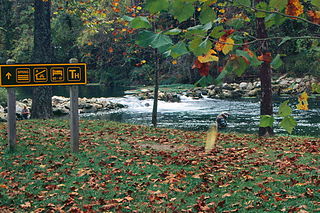
Bennett Spring State Park is a public recreation area located in Bennett Springs, Missouri, twelve miles (19 km) west of Lebanon on Highway 64 in Dallas and Laclede counties. It is centered on the spring that flows into the Niangua River and gives the park its name. The spring averages 100 million gallons of daily flow. The park offers fly fishing, camping, canoeing, hiking, and other activities.
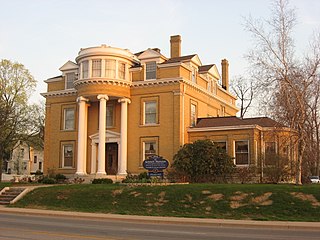
The East Main Street–Glen Miller Park Historic District is a neighborhood of historic residential buildings and national historic district located at Richmond, Wayne County, Indiana. The district encompasses 84 contributing buildings, 11 contributing structures, and 5 contributing objects along the National Road and sometimes called Millionaire's Row. A portion of the district is recognized by the City of Richmond's Historic Preservation Commission as the Linden Hill conservation district. It developed between about 1830 and 1937 and includes representative examples of Italianate, Queen Anne, Colonial Revival, Tudor Revival, Classical Revival, and Bungalow / American Craftsman style architecture. Located in the district is the separately listed Henry and Alice Gennett House. Other notable contributing resources include elaborate iron bridges and "Madonna of the Trail" statue located in Glen Miller Park, Isham Sedgwick House (1884-1885), John A. Hasecoster House (1895), William H. Campbell House (1905), Howard Campbell House (1909), E.G. Hill House, Crain Sanitarium, and Dr. T. Henry Davis House.

Clarksville Historic District is a national historic district located at Clarksville, Pike County, Missouri. The district encompasses 65 contributing buildings in the central business district and surrounding residential sections of Clarksville. It developed between about 1840 and 1930, and includes representative examples of Greek Revival, Italianate, and Queen Anne style architecture. Located in the district is the separately listed Clifford-Wyrick House. Other notable buildings include the City Hall (1910), Sentinel Building (1867-1871), Clifford Banking Company, La Crosse Lumber Company (1923), Presbyterian Church, Methodist Church (1906), Masonic Temple (1903), and Clarksville Public Library (1910).

The Clarksville Historic District is a national historic district located at Clarksville, Mecklenburg County, Virginia. It encompasses 171 contributing buildings, 2 contributing sites, and 1 contributing structure in the central business district and surrounding residential areas of the town of Clarksille. Notable buildings include the Planters Bank (1909), Planters Brick Tobacco Sales Warehouse, Gilliland Hotel, the Russell's Furniture, former Clarksville High School (1934), Clarksville Presbyterian Church, Mount Zion Baptist Church, Jamieson Memorial Methodist Episcopal Church (1901), St. Timothy's Episcopal Church (1917), and St. Catherine of Siena Roman Catholic Church (1947). Located in the district are the separately listed Clark Royster House and the Judge Henry Wood Jr. House.

Waddell House, also known as Pastorium of the First Baptist Church or Van Amburg House, is a historic home located at Lexington, Lafayette County, Missouri. It was built about 1840, and is a two-story, red brick dwelling on a partial basement. It features decorative elements such as clustered chimney pots, scalloped vergeboards with pendants, and a spindled stickwork Late Victorian porch with mansard roof. William Bradford Waddell acquired the house in trade for stock in the local Baptist Female College in 1869.

The St. Charles Historic District is a national historic district located at St. Charles, St. Charles County, Missouri. It is the site of the first permanent European settlement on the Missouri River and of the embarkation of Lewis and Clark's journey of exploration along the Missouri. The first state capital of Missouri and over one hundred other historic buildings are located in the district.

Harris Addition Historic District is a national historic district located at St. Joseph, Missouri. The district encompasses 288 contributing buildings and 1 contributing site in a predominantly residential section of St. Joseph. It developed between about 1866 and 1940, and includes representative examples of Colonial Revival, Tudor Revival, and American Craftsman style architecture. Notable buildings include the William Payne House (1889), W.C. Green Apartment Building, C.B. Powers House, the Parry-Motter House designed by architect Edmond Jacques Eckel (1845–1934), and a number of speculative houses built by George J. Englehart and W.H. Haynes.

Hall Street Historic District is a national historic district located at St. Joseph, Missouri. The district encompasses 43 contributing buildings in a predominantly residential section of St. Joseph. It developed between about 1870 and 1920, and includes representative examples of Italianate and Late Victorian style architecture. Notable buildings include the Karl Schatz House, Rolanda Court Apartments, Chase-McClain House (1870s), John Forest Martie House, Oak Ridge Apartments (1890), James H. Robinson - William W. Wheeler House (1883), Cummings Ogden House (1885), Bill Osgood House (1890), and Missouri Methodist Hospital - Huggins House (1908).
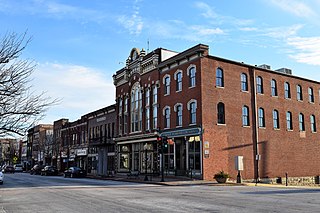
Missouri State Capitol Historic District is a national historic district located at Jefferson City, Cole County, Missouri. It encompasses 122 contributing buildings in the central business district of Jefferson City. The district developed between about 1850 and 1950, and includes representative examples of Classical Revival, Late Victorian, Queen Anne, Mission Revival, and Modern Movement style architecture. Located in the district are the separately listed Missouri State Capitol, Lohman's Landing Building, Cole County Historical Society Building, Cole County Courthouse and Jail-Sheriff's House, Missouri Governor's Mansion, and Tergin Apartment Building. Other notable buildings include the St. Peter's Roman Catholic Church complex (1881-1883), Margaret Upshulte House, Broadway State Office Building (1938), Supreme Court of Missouri (1905-1906), U.S. Post Office and Courthouse (1932-1934), Lohman's Opera House, Missouri State Optical, First United Methodist Church (1900), Carnegie Public Library (1901), Temple Beth El (1883), and Joseph and Susie Kolkmeyer House.

New Franklin Commercial Historic District, also known as Downtown New Franklin, is a national historic district located at New Franklin, Howard County, Missouri. The district encompasses 19 contributing buildings and 1 contributing object in the central business district of New Franklin. It developed between about 1894 and 1931 and includes representative examples of Queen Anne and Romanesque Revival style architecture. Notable contributing resources include the John B. and Logie R. Fleet House, U.S. Post Office, Home Electric Company Office, Carpenter and White Building, Bethke's German Cash Store (1909), Citizen's Bank (1894), and Santa Fe Trail Marker (1913).

Edina Double Square Historic District is a national historic district located at Edina, Knox County, Missouri. The district encompasses 37 contributing buildings in the central business district of Edina. It developed between about 1865 and 1945 and includes representative examples of Italianate and Streamline Moderne style architecture. Notable contributing buildings include the Public Works Administration funded Knox County Courthouse (1934–1935) designed by William B. Ittner, Bishoff Bakery (1891), Northern Hotel (1860s), Ennis House/Northern Hotel, Edina School and Gymnasium (1915–1916), D. H. Mudd Building, Phillip Linville Building, Tobias J. Lycan Building, Jacob Pugh Building, Albert G. Bostick Building, Knox County Savings Bank, Thomas Burk Buildings, Bank of Edina Building, Joseph F. Biggerstaff Buildings, Stablein Building, and Knox County Public Library.
Spratt-Allen-Aull House is a historic home located at Lexington, Lafayette County, Missouri. It was built about 1840, and is a two-story, Greek Revival style red brick dwelling. It features a colossal pedimented tetrastyle portico with a full-facade upper deck. Also on the property is the contributing octagonal, two-story frame ice house.
Commercial Community Historic District is a national historic district located at Lexington, Lafayette County, Missouri. The district encompasses 106 contributing buildings and 1 contributing structure in the central business district and surrounding residential area of Lexington. It developed between about 1830 and 1930, and includes representative examples of Late Victorian and Gothic Revival style architecture. Located in the district is the separately listed Lafayette County Courthouse. Other notable buildings include the Lexington Racquetball Club, Missouri Public Service Storage Building, Franklin Diner, Wright House, Goehner's Marbleworks, First Presbyterian Church, Municipal Auditorium (1930), Leiter Apartments, Lafayette County Sheriff's Office and Jail (1939), Morrison Wentworth Bank Building, and Winkler Theatre.

Old Neighborhoods Historic District is a national historic district located at Lexington, Lafayette County, Missouri. The district encompasses 267 contributing buildings in a predominantly residential section of Lexington. It developed between about 1830 and 1930, and includes representative examples of Late Victorian and Greek Revival style architecture. Located in the district are the separately listed Cumberland Presbyterian Church and Waddell House. Other notable contributing resources include the McGrew House, Schacklett House, Waddell-Pomercy House, Waddell-Young House, First Christian Church, Walter B. Waddell House, Eggleston House, Lafayette Arms, United Methodist Church, Reorganized Church of Jesus Christ of Latter Day Saints, Marquis W. Withers House, John Eggleston House, Christ Church Episcopal, Trinity United Church of Christ, Old German Catholic Church, and Lexington Middle School.
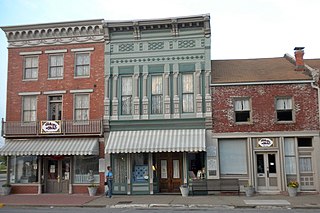
Mark Twain Historic District is a national historic district located at Hannibal, Marion County, Missouri. The district encompasses 20 contributing buildings in the central business district of Hannibal. It developed between about 1840 and 1936. Located in the district is the separately listed Mark Twain Boyhood Home. Other notable buildings include the Ice House Theatre, Randall House Antiques, Information Center, House of the Pilasters & Grant's Drug Store (1839-1844), "Becky Thatcher" House, and the Mark Twain Memorial Lighthouse (1936).

Central Park Historic District is a national historic district located at Hannibal, Marion County, Missouri. The district encompasses 261 contributing buildings, 1 contributing site, and 4 contributing structures in a predominantly residential section of Hannibal. It developed between about 1840 and 1939, and includes representative examples of Romanesque Revival, Late Victorian, and Art Deco architecture. Located in the district are the separately listed Federal Building, Hannibal Old Police Station and Jail, and Eighth and Center Streets Baptist Church. Other notable contributing resources include Central Park with a war memorial monument and a life-size bronze statue of William Henry Hatch (1833-1894), City Hall (1909), old Missouri Guaranty Building (1894), Price Apartments (1904), YMCA (1910), Masonic Temple (1882), Park Methodist Church, Retards Row (1855), Elks Building (1925), Holmes Building, Security Building (1912), Kerchival-Iakenan-Lathrop House, Admiral Coontz Birthplace, Inmaculate Conception Chapel (1854), Episcopalian Trinity Church (1860), and William C. Henn House (1937).

North Third Street Historic District is a national historic district located at Louisiana, Pike County, Missouri. The district encompasses 61 contributing buildings, one contributing site, and contributing structure in a predominantly residential section of Louisiana. It developed between about 1843 and 1935 and includes representative examples of Greek Revival, Gothic Revival, Italianate, Queen Anne, Colonial Revival, and Bungalow/American Craftsman style architecture. Located in the district are the separately listed Louisiana Public Library and Luce-Dyer House. Other notable buildings include the William C. Hardin House, James H. Johnson House, Edward G. McQuie House, St. Joseph's Catholic Church (1874), and Frank Boehm, Jr. House.
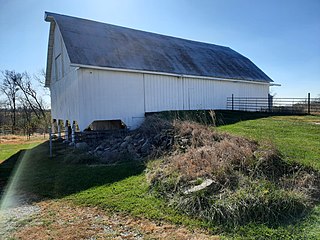
Isiah Mansur Farmstead Historic District, also known as Rock Hall, is a historic home and farm and national historic district located near Richmond, Ray County, Missouri. The district encompasses eight contributing buildings, one contributing site, and three contributing structures on a farm developed between the mid-19th and mid-20th centuries. The contributing resources include the main farmhouse, a buggy house, a large barn, an engine house (c.1900), a small barn, a brooder house, a hen house, a smokehouse, a house well, a field well, and a wellhouse. The main farmhouse is a two-story, five bay, frame I-house.






















